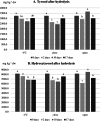Exploitation of virgin olive oil by-products (Olea europaea L.): phenolic and volatile compounds transformations phenomena in fresh two-phase olive pomace ('alperujo') under different storage conditions
- PMID: 34676895
- PMCID: PMC9298029
- DOI: 10.1002/jsfa.11593
Exploitation of virgin olive oil by-products (Olea europaea L.): phenolic and volatile compounds transformations phenomena in fresh two-phase olive pomace ('alperujo') under different storage conditions
Abstract
Background: Much effort has recently been spent for re-using virgin olive oil by-products as nutraceutical ingredients for human diet thanks to their richness in bioactive phenols, but their management is not easy for producers. We aimed to provide useful information for a better management of fresh olive pomace before drying, by studying the phenolic and volatile compounds transformations phenomena of fresh olive pomace stored under different conditions planned to simulate controlled and uncontrolled temperature conditions in olive oil mills.
Results: The evolution of the phenolic and volatile compounds was studied by high-performance liquid chromatography-diode array detector mass spectrometry (HPLC-DAD-MS) and headspace solid-phase microextraction gas chromatography-mass spectrometry (HS-SPME-GC-MS). The phenolic profile varied rapidly during storage: the verbascoside content decreased about 70% after 17 days even at 4 °C, while the content of simple phenols such as hydroxytyrosol and caffeic acid increased over time. The low temperature was able to slow down these phenomena. A total of 94 volatile organic compounds (VOCs) were detected in the fresh olive pomace, with a prevalence of lipoxygenase (LOX) VOCs (78%), mainly aldehydes (19 490.9 μg kg-1 ) despite the higher number of alcohols. A decrease in LOX volatiles and a quick development of the ones linked to off-flavors (carboxylic acids, alcohols, acetates) were observed, in particular after 4 days of storage at room temperature. Only storage at 4 °C allowed these phenomena to be slowed down.
Conclusion: To preserve the natural phenolic phytocomplex of fresh olive pomace before drying and to avoid off-flavors development, storage in open containers must be avoided and a short storage in cold rooms (7-10 days) is to be preferred. © 2021 The Authors. Journal of The Science of Food and Agriculture published by John Wiley & Sons Ltd on behalf of Society of Chemical Industry.
Keywords: HS-SPME-GC-MS; nutraceuticals; olive mill by-products; olive pomace storage; polyphenols; secoiridoids.
© 2021 The Authors. Journal of The Science of Food and Agriculture published by John Wiley & Sons Ltd on behalf of Society of Chemical Industry.
Conflict of interest statement
The authors declare no conflict of interest.
Figures




References
-
- IOC , 2020. Available: https://www.internationaloliveoil.org/what-we-do/economic-affairs-promot... [8 August 2020].
-
- Ciriminna R, Meneguzzo F, Fidalgo A, Ilharco LM and Pagliaro M, Extraction, benefits and valorization of olive polyphenols. Eur J Lipid Sci Technol 117:503–511 (2016).
-
- Lozano‐Sanchez J, Bendini A, Di Lecce G, Valli E, Gallina Toschi T and Segura‐Carretero A, Macro and micro functional components of a spreadable olive by‐product (pâté) generated by new concept of two‐phase decanter. Eur J Lipid Sci Technol 119:1600096 (2017).
-
- Rubio‐Senent F, Rodriguez‐Gutierrez G, Lama‐Munoz A and Fernandez‐Bolanos J, New phenolic compounds hydrothermally extracted from the olive oil byproduct alperujo and their antioxidative activities. J Agric Food Chem 60:1175–1186 (2012). - PubMed
-
- Simonato B, Trevisan S, Tolve R, Favati F and Pasini G, Pasta fortification with olive pomace: effects on the technological characteristics and nutritional properties. LWT – Food Sci Technol 114:108368 (2019).
MeSH terms
Substances
Grants and funding
LinkOut - more resources
Full Text Sources
Miscellaneous

